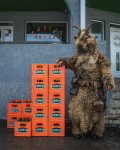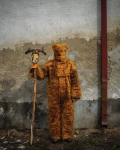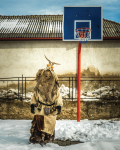Although we might expect a photo reportage of the festival atmosphere of Bamburci from village Ratevo, Macedonia, in a recognizable photographic expression from Dženat Dreković, striving to document this unique phenomenon and thereby confirm his photographic style, the author decided to try to objectify his ‘magical realism’ and gave us an unexpected result.
The exhibition “Dženat Dreković – Bamburci” opens to the public on Wednesday, June 11, 2025, at 7 PM at the History Museum of Bosnia and Herzegovina (Zmaja od Bosne 5, 71000 Sarajevo).
About the Exhibition
Bamburci, as a unique cultural and social phenomenon, appear every year in January, celebrating the feast of St. John the Baptist, in the village Ratevo, Macedonia. The villagers wear distinctive fur costumes to drive away ‘evil spirits’ out of the village before spring. But also, Bamburci can not be women, neither old people, but only young men who no longer live in the village.
Contemporary geopolitical and technological tendencies and global circumstances have caused that even those who are the most energetic ones in driving away ‘evil forces’ – young men, would also, for various reasons, give up and leave rural areas, and tradition, which makes this photo-cycle an exceptional visual paradox. Dženat Dreković remembers the mystical Bamburci as a child, and with this photo-cycle he seeks to record the atypical ‘horror vacui’ of the modern era in which someone who was supposed to drive-away ‘evil spirits’ from the village, remains the only inhabitant there.
Although at first glance we might notice the folklore content and be fascinated by the mythological subject in Dreković’s photo-cycle, Dreković tries to objectify the content by displacing the Bamburci from the role of the subject, photographing them in an almost empty environment in daylight during the day, which makes Bamburci a ‘contemporary object’, and Dreković’s expression of mysticism almost becomes an autobiographical sketch.
While displacing the Bamburci from the expected space-time context of the mystical or pagan within the festival ceremony of the village Ratevo, Dreković presents their daily activities or actions as almost strange, which makes the Bamburci to be perceived as guests into the village or some kind of living beings from some other planet visiting the village, even though they actually originated from that village. The ‘visual silence’ contributes to the feeling of loneliness of Bamburci in the photos, and the unexpected scenes of moments of deviation from the established tradition and costumes rules bring a new charm, or even a new rule, and thus a new, contemporary tradition.
The uniqueness of this photo-cycle is found in the category of time – the gap, the flow, and the passing of time, in three lines: the first one, in which Dreković documents the Bamburci before, during and after the festival ceremony in the village; the second one, in which the Bamburci in front of Dreković’s lens become almost like some special biological species or uninvited beings who come and occupy the village from which they originated; and third one, in which Dreković emphasizes the autobiographical line of time, or his return to the village to round-out his ‘visual journey’ with the memory on Bamburci he has from his childhood.
While understanding the image of the world, we are usually guided with an approach to understand the present from the pagan, or from the past, but Dreković brings us an unexpected photographic approach in which the past is understood from the present, and following that he unites the gap in time between his childhood and perhaps the last moment when he saw Bamburci in his village again. Could someone else have done this? No. Dženat Dreković had to complete his cycle of life.
– Armin Ćosić, Exhibition Designer-
About the Author
Dženat Dreković (b. 1979, Berovo, North Macedonia) graduated in Photography from the Academy of Fine Arts in Belgrade and completed the World Press Photo Masterclass in Berlin. Currently, he is pursuing his postgraduate studies in Photography at the Academy of Fine Arts in Sarajevo. He gained his work experience as a photojournalist for daily newspapers and weekly magazines, as well as an assistant in subjects of Media Photography and Applied Photography at the Faculty of Technical Studies (FTS). He was a guest lecturer at the Pacific University of Oregon, a member of the Association of Fine and Applied Arts & Artists of Bosnia and Herzegovina (ULUPUBiH), and a co-founder and collaborator of CFFM (Center for Photography, Film, and Multimedia Sarajevo). He was the founder and director of the first Bosnian-Herzegovinian photography gallery, “Fotogalerija Jelićeva”. He has exhibited in numerous solo and group exhibitions in Bosnia and Herzegovina, the region, and worldwide. He lives in Sarajevo and works as a photographer and videographer.



